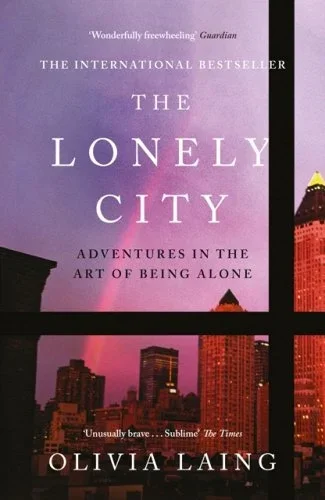The Lonely City: Adventures in the Art of Being Alone by Olivia laing
Olivia Laing’s The Lonely City: Adventures in the Art of Being Alone is part memoir, part art criticism, and part meditation on what it means to be lonely in a world built for connection. Set against the backdrop of New York City, Laing weaves her own solitude with the lives of artists like Edward Hopper, Andy Warhol, and David Wojnarowicz, showing how isolation can spark creativity
Loneliness
I’ve read and reviewed a number of non-fiction books about loneliness - I am an Island by Tamsin Calidas was a tough but inspiring memoir, whilst The Lonely Century by Noreen Hertz was a well researched and readable book about the epidemic of loneliness we are currently experiencing. Lost Connections by Johann Hari also looked at how disconnected our lives have become.
So it’s a subject I’ve returned to a number of times on this blog. I have an interest in reading about longing, about presence, about the gaps between people. Also about what lies behind it - silence, stillness and presence. There’s no doubting loneliness can be devastating physically and emotionally, but if we can learn to sit with solitude, it can become something else entirely.
‘The lonely city’ takes a different approach. After a painful breakup which results in a move to New York, Laing uses artists lives to reflect on isolation. These artists include such as Edward Hopper, Andy Warhol, Henry Darger, David Wojnarowicz, Klaus Nomi, Josh Harris, and Vivian Maier. What we end up with is a book that mixes personal memoir with cultural commentary about introspection, and how solitude can be creative rather than just painful.
Edward Hopper
I was familar with some of the paintings of Edward Hopper, not so much about his life. Unsurprisingly, he cuts an isolated figure, living an inward, self contained existence.
‘Hopper painted solitude because he knew it intimately; the stillness in his rooms and diners came from the stillness within him.’
I enjoyed the insights from Laing about Hoppers most famous painting, ‘Nighthawks’. As she points out, there’s no visible door to the outside in the diner, a detail that I dwelled on for a bit. Those inside are trapped, whilst we are always on the outside, looking in. Maybe that’s what modern living is like for many of us - urban loneliness means that connection feels inaccessible. It also added a sense of unease to the painting.
‘Automat’ is another one I sat with for a while, along with ‘Early Sunday Morning’ and ‘Office in a small city’. These empty streets, glassed in diners and isolated figures aren’t just scenes - they represent states of being, the emotional architecture of loneliness.
Andy Warhol
The other artist whose work I was slightly familar with was Andy Warhol. I learnt a different side of him here - not the cultish, cool, detached pop idol but rather as someone deeply lonely, and vulnerable, despite being constantly surrounded by hangers on.
Laing tells us how Warhols troubled, sickly childhood gave him conflicting feelings towards intimacy; he often feared it whilst simultaneously craving it. His methods of working, his tape recorder, polaroids and video cameras, keep a barrier between him and his relationships.
“If you keep the lens between yourself and the world, nothing can really touch you.”
His methods of working become shields against vulnerability, and made me think a lot about how he was ahead of the game. Look at us now, with these carefully curated online personas.
This was one of my favourite sections, talking as it does about how modern life highlights our contradictions around intimacy, about visibility, and longing. Cities amplify these tensions, how we want to be seen but at the same time we want to protect ourselves. We crave intimacy, but worry about becoming too exposed. And ultimately we choose to surround ourselves with people, but feel even more isolated.
Was it Bukowski who said “You can be in a crowd full of people and still feel utterly alone?” Satre said something similar in ‘nausea’ - “I am alone in the midst of these happy, reasonable voices. All these people… they don’t know I exist.”
David Wojnarowicz, Klaus Nomi, Henry Darger, Nan Goldin
Although I wasn’t familiar with the work of the other artists that Olivia Laing writes about, I did find their backgrounds and modes of expression to be interesting. I found myself scouring the interweb for their works, and have watched some youtubes as well. Always enjoy discovering new artists, and the New York scene was rife with them, especially during the 80’s.
David Wojnarowicz felt very much like the emotional heart of the book, a queer artist and activist who uses his art to rage against political, personal and social silence during the AIDS crisis. There’s a raw energy to both his writing and mixed media works, a real kicking back against the pricks, which explores abandonment, shame, and connection when time is of the essence.
Klaus Nomi was a German countertenor who was a fixture of the 1980’s New York counterculture scene. No surprise that he collaborated with Bowie, and there’s something otherworldly about him. I’ve watched a few performances on Youtube, but there’s something about this one that just stops me. It’s ‘The cold song’ from Henry Purcells' ‘King Arthur’ where this haunted, white faced figure sings about being woken from eternal sleep, shivering and pleading to be allowed to return to cold and silence.
The poignancy comes from the fact that Nomi is gravely ill with AIDS; he’s dead a year later, at the age of 39. This is one of the strengths of the book - Laing doesn’t just describe loneliness, but finds it embodied in art.
Other artists include Henry Darger, a reclusive hotel janitor who is experiencing extreme solitude and building a fantastical inner world - he creates an epic, 15000 word fantasy manuscript with hundreds of illustrations only discovered after his death.
Nan Goldin is covered more briefly, and offers a contrast to Warhols cold distance - there’s a vulnerability in her messy yet beautiuful pictures of intimacy, relationships and the families we choose.
Summary
Took me an absolute age to get through this book as I was forever diving into youtube and internet searches of the many works mentioned. The artists stories together illuminate the many different aspects of loneliness that people feel, and sometimes use as the inspiration for their art.
I liked how Laing weaves her own story of dislocation and longing with that of the artists who knew loneliness inside out. From Hoppers quiet diners, Warhols mirrored distances to Wojnarowicz’s fury and Goldins raw intimacy - each tells us what it is to be human and separate.
Like I said in the opening paragraph, this is part memoir, part art criticism, part meditation on loneliness, and not at all what I was expecting and all the better for it. I felt I came away knowing something deeper about solitude, connection, and the strange, tender ways we try to make sense of ourselves. Unusual book that I took my sweet time with and enjoyed.
326 pages First published March 2016
I no longer include Amazon links in my reviews. Please support your local library and bookshops. Libby is also great.
If you do wish to purchase online, feel free to support independent bookshops and contribute to the hosting of this website by purchasing via Bookshop.org



